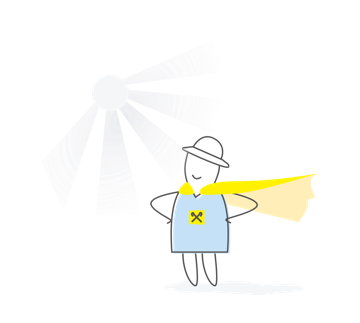Which financial programs do agrarians need?
Historically, loans were one of the sources of agricultural companies’ development. 2020 is not an exception and as usual our Bank is the leader in this area of financing. “As we can see, agrarians are reviewing their strategies for fund raising. Decrease of the volumes of agricultural investment programs lending is a characteristic feature of this season”, outlines Denys Honcharuk, head of partner programs development of Raiffeisen Bank Aval JSC.
Currently agricultural entrepreneurs of micro and small segment (with the proceeds up to UAH 90-100 mn and the land bank up to 3-5 k ha depending on the region) are the most active ones.
Bigger agricultural enterprises (from 5k to 40k ha) have already cut their investment needs. Reduction of financial needs of Ukrainian agricultural producers is driven by several factors. The strictest quarantine restrictions were imposed during the spring field works, but still COVID-19 pandemic does not play a key role for agricultural sector and only makes the situation more uncertain.
Grounds for transformation
Such caution is brought about by the expectations of land market opening that will be launched starting from July 1, 2021. It is undoubtedly a reason for concern that hampers investments in this sector. Agrarians endeavor to be prepared beforehand by accumulating financial resources. Obviously, market players cannot dispense with the essentials (seed, fertilizers, plant protection agents) but they are much more reserved in the updating of technologies, machine and tractor fleet, implementation of long-term capital-intensive development programs. Not all producers are certain that they will be able to keep the current land bank and that is why they spend funds for the purchase of new agricultural machinery only in case of significant need.
In addition, crop production profitability has significantly decreased during the last five years despite the record-high harvest and constant increase of crops yield. According to the data of the State Statistics Service of Ukraine, last year grain production profitability decreased to 11.8%, whereas in the previous years the average profitability amounted to approximately 30%. It is the lowest indicator since 2014. The situation is similar with sunflowers. Last year sunflowers production profitability constituted only 23.5%, whereas in the previous years the average profitability amounted to approximately 50%.
Profitability reduced because the costs for agricultural production resources and the lease pay for the land increased, whereas the prices for grain and oil crop decreased. It goes without saying that there are concerns that low prices for agricultural products in the world markets along with low crop yields will further worsen the financial standing of agricultural enterprises.
The third aspect is hryvnia revaluation in the second half of 2019. Last year the producers sowed when the exchange rate of hryvnia against the US dollar amounted to 27, and harvested when the exchange rate was 23-24. As a consequence, considering the increase of costs for material and technical resources, Ukrainian agrarians did not receive a significant part of profit for the products in comparison with the expected amount of profit.
“The margins of the agriculture decreased. Due to the revaluation of hryvnia and receipt of lower profit, official financial reporting of many agrarians is less attractive now. Unfortunately, balance sheets of such enterprises do not allow banking institutions to increase credit financing, as in previous years”, notes Denys Honcharyk.
Banking products
If until the last year the bank offered financing of fertilizers purchase only on the terms and conditions of standard interest rates that were not so attractive for agrarians (17-18% per annum), now due to the cooperation with the partners-manufacturers and sellers, as well as terms and conditions of exclusive partner programs, Raiffeisen Bank Aval offers interest rates for fertilizers starting from 0.01% per annum.
In addition, agricultural producers keep using programs for financing via promissory notes for the purchase of seeds, planting material, mineral and micro fertilizers, plant protection agents, irrigation and drip watering equipment.
Commission fee for guarantee provision under the promissory note is starting from 1%, payment delay – up to 9 months: it makes the product convenient and advantageous. Demand for the working capital financing programs, interest rate under which is starting from 0.01% and financing period of which amounts to 12 months, remains stable.
“Using promissory notes entrepreneurs promptly satisfy their needs in the purchase of seeds and plant protection agents. Despite negative external factors, we have not reduced the volume of promissory notes provision. Today Raiffeisen Bank Aval is leading in this product - the volume of avals on promissory notes amounts to UAH 2.3 b”, points out Denys Honcharuk.
On the eve of the autumn sowing, we offer our customers beneficial joint financial programs. Exclusive deals with the brands Bayer, Monsanto, DuPont and Pioneer. companies Corteva, Syngenta and fertilizers distributors will allow to satisfy the needs of agrarians in goods and materials of higher quality, which will facilitate the improvement of their financial indicators.
The Bank actively participates in the projects aimed at promotion of cashless settlements with the shareholders. Advantages of this for agrarians and shareholders are transparency and easy administration. The Bank offers beneficial terms and conditions of cooperation for agricultural producers that make cashless transactions.
In addition, RBA has interesting products related to irrigation, which are first of all relevant for agrarians from southern regions. Producers that increase irrigation areas are considered the best customers for the Bank since their economic activities are most predictable. However, considering the current financial standing of agricultural companies in southern regions, loan debt burden of the enterprises and partial loss of the harvest due to the drought, the Bank possibilities regarding the meeting of the needs of such customers are unfortunately limited.
Participation of bank in the state support programs
The state is not indifferent to the urgent problems of agrarians. After the launch of the program Affordable Loans 5-7-9, developed by the Cabinet of Ministers and the National Bank, the situation with the state support of the agricultural sector gradually improves.
In May RBA signed the Cooperation agreement with the Business development fund and consequently the Bank’s customers can take advantage of the terms and conditions of subsidized financing under the Program 5-7-9. In addition, the Program of partial compensation of the price during the purchase of domestic agricultural machinery is extended for 2020 and RBA customers continue receiving the state support in this area.
Starting from 2020 new initiatives regarding the compensation of interest rates under the loans to agricultural producers are implemented. Recently the state has signed memorandums with the banks on the mechanisms for compensation of interest rates under the loans and officially delegated banking institutions the mission of documents collection and submission of compensation registers to the Ministry of economy. What counts most for all market players is that the compensation mechanism becomes more transparent. Earlier the scheme for compensation and payment of the state compensation to agricultural companies was too complicated, entrepreneurs had to submit documents for compensation for consideration of regional commissions. The compensation process was long, non-transparent and inconvenient. On the one hand, in the current conditions the Bank’s responsibility in terms of documents collection and compensation accrual increases, load for current processes increases too. On the other hand, it will increase the value of the Bank that provides high-quality services to its customers in more and more areas.
“It was only the first year when the compensations under loans were paid to the agricultural producers via the banks but the demand for the participation in this program is pretty high. Financing of the agrarians’ production needs for the period up to one year constitutes up to 50% of our products. After the significant simplification by the state of the compensation procedure for the customers, we expect that next year the number of agrarians applying for the bank loans, as well as demand for the financing in this sector will significantly increase”, forecasts Denys Honcharuk. It is also worth mentioning that a customer has an opportunity to submit documents package only to one servicing bank (under loan agreements concluded with this bank), which will facilitate “consolidation” of limits for agrarians in one financial institution for the maximization of the state compensation, which in its turn will also affect the market.















